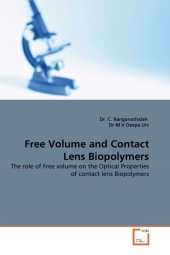 Neuerscheinungen 2010Stand: 2020-01-07 |
Schnellsuche
ISBN/Stichwort/Autor
|
Herderstraße 10
10625 Berlin
Tel.: 030 315 714 16
Fax 030 315 714 14
info@buchspektrum.de |

Dr M V Deepa Urs, C. Ranganathaiah
(Beteiligte)
Free Volume and Contact Lens Biopolymers
The role of Free volume on the Optical Properties of contact lens Biopolymers
2010. 180 S.
Verlag/Jahr: VDM VERLAG DR. MÜLLER 2010
ISBN: 3-639-30369-5 (3639303695)
Neue ISBN: 978-3-639-30369-8 (9783639303698)
Preis und Lieferzeit: Bitte klicken
The development of new contact lenses is an important technological breakthrough and this branch of science is still expanding with tremendous growth. Contact lenses are a successful form of vision correction, used by approximately 90 million people worldwide. One of the challenging problems encountered by this community is Opacification or loss of optical transparency of the contact lens materials. The tear components like chlorides of sodium and calcium, phosphates, glucose, lipids, proteins etc., may interact and diffuse into the lens material. This will certainly bring about a change in lens structure and its properties. The particular property of great importance in lenses is the refractive index, which is directly related to polarizability of the lens material. Since refractive index n´ of lens material is the major criteria in determining power of the lens, slightest change in polarizability can change the refractive index and hence the power of the lens. It is well established that Positron Lifetime Spectroscopy (PLS) is the best and sensitive probe of electron density distribution in a system of study.


